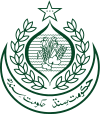Moinuddin Haider
General (R) Moinuddin Haider | |
|---|---|
معین الدین حیدر | |
| Federal Minister of Interior and Narcotics Control | |
| In office 6 November 1999 – 23 November 2002 | |
| President | General Pervez Musharraf |
| Preceded by | Shujaat Hussain |
| Succeeded by | Faisal Saleh Hayat |
| Governor of Sindh | |
| In office 17 March 1997 – 17 June 1999 | |
| President | Rafiq Tarar |
| Prime Minister | Nawaz Sharif |
| Preceded by | Kamaluddin Azfar |
| Succeeded by | Mamnoon Hussain |
| Chief Executive of Sindh | |
| In office 30 October 1998 – 17 June 1999 | |
| Preceded by | Governor’s Rule |
| Succeeded by | Ghous Ali Shah |
| Corps Commander Lahore | |
| In office 1996–1997 | |
| Adjutant General | |
| In office 1993–1996 | |
| Deputy Chief of General Staff | |
| In office 1991–1993 | |
| Commander 33rd Infantry Division, (Quetta) | |
| In office 1989–1991 | |
| Director-General Military Training | |
| In office 1986–1989 | |
| Personal details | |
| Born | 5 June 1942 Delhi, British India |
| Nationality | Pakistani |
| Spouse | Shahnaz Haider |
| Children | Captain (r) Noman Uddin Haider, Bohran Uddin Haider, Asma Haider |
| Residence(s) | Karachi, Pakistan |
| Alma mater | |
| Committees | |
| Awards | Hilal-i-Imtiaz (Military) |
| Military service | |
| Allegiance | |
| Branch/service | |
| Years of service | 1962 - 1997 |
| Rank | |
| Unit | F.F. Regiment |
| Commands |
|
| Battles/wars | |
Moinuddin Haider, HI(M) (Urdu: معین الدین حیدر; born 5 June 1942) is a retired three-star rank general of the Pakistan Army, who later served as the Governor and Chief Executive of Sindh, and then as the Federal Interior Minister of Pakistan. He has also served as Chairman Askari Bank, and was the top choice for media representation by the Inter-Services Public Relations (ISPR).
Army career
Haider was commissioned in the Pakistan Army in 1962 first in the 26th PMA Long Course in the Frontier Force Regiment. He earned his master's degree in defence studies from the Royal College of Defence Studies in Seaford House UK, and was the first Pakistani to get his thesis published in Seaford House Papers.[1]
He saw action in the 1965 and the 1971 Indo-Pak wars. He served as instructor at the Pakistan Military Academy from 1967 to 1970. He commanded a reconnaissance and support battalion twice in 1975–77 and in 1981–82. Later he was head of Pakistan Mutual Cooperation Group in Somalia from 1978 to 1981. Subsequently, he served as GSO-I operations and colonel staff in an infantry division. He also served as Martial Law Administrator of Northern Sindh, and Director General Military Training.
Senior command and staff appointments
Promoted to brigadier in 1983, he left for the UK to attend Royal College of Defence Studies course in 1984 and was the first Pakistani officer whose thesis was published in Seaford House papers. He was appointed director military training at GHQ in 1986 and was closely associated with planning of Zarb-e-Momin.
As a two-star, Haider commanded the 33rd Infantry Division at Quetta from 1989 to 1991. He then stayed as the Deputy Chief of General Staff (DCGS) at the GHQ from 1991 to 1993. After becoming a three-star general, he first served as the Adjutant General (AG) from 1993 to 1996, and then as the Corps Commander Lahore from 1996 to 1997. In the last days of his tenure as Cor Commander Lahore he was appointed Governor Sindh.
Government service
After retirement in March 1997, he was installed as the Governor of Sindh province by the Nawaz Sharif government. In October 1998, he assumed all powers and functions of the state government and took place as the Chief Executive of Sindh after the sacking of Liaquat Ali Jatoi’s unpopular government and imposition of Governor's rule. He continued to serve as the governor until June 1999 when he was replaced by Mamnoon Hussain. At the onset of military coup in October 1999, General Pervez Musharraf, a junior to Haider as he belonged to 29th PMA Long Course, put Haider as the Federal Interior Minister of Pakistan. He continued to lead the powerful ministry until the 2002 October elections, when Faisal Saleh Hayat replaced him. During his time as Interior Minister he was very involved in hunting down and bringing to justice the killers of American Wall Street Journal reporter Daniel Pearl. He was also involved in crackdown against militants and banned organisations, which led to the assassination of his brother in Karachi. During his tenure his work was not just limited to his ministry, but he also played a major role in foreign relations, visiting several countries and interacting with heads of states.
Moinuddin Haider is the graduate of PAF Public School Lower Topa and is the current patron in chief of the Lower Topa Old Boys Association (LOBA).[2] He is currently Chariman of Fatimid Foundation. He has also adopted several schools and is on the board of many universities and colleges. He continues to appear on the media frequently and his name was on top of the list issued by ISPR for representation on media. He is married and has three children.
References
- ^ Quarterly Newsletter July–September 2020. Retrieved 4 December 2022
- ^ "Old Topians reunite" Daily Times, 28 July 20
External links
- Biography of Moinuddin Haider
- Profile at National Police Bureau
- Interview of Lt Gen (retd) Moinuddin Haider

